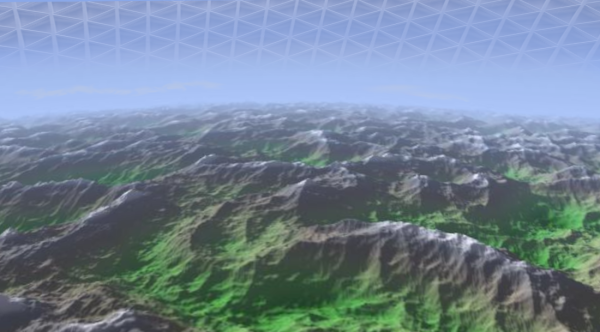BY LETTER
Bluesky Worldhouses
Technology > Technology Type or Material > Drytech/Hylotech
Technology > Technology Levels > High Tech / Hitech
Technology > Application > Infrastructure
Technology > Application > Megascale Engineering
Technology > Technology Type or Material > Nanotech
Technology > Technology Levels > High Tech / Hitech
Technology > Application > Infrastructure
Technology > Application > Megascale Engineering
Technology > Technology Type or Material > Nanotech
 Image from Steve Bowers | |
| The Bluesky Worldhouse on Ordinatus III, seen from inside | |
The impermeable bluesky membrane used in this kind of worldhouse consists of several layers of tiled cells, usually triangular or hexagonal, but often more complex pentagons. These were are filled with inert gas, usually nitrogen; the pressure in each layer being less than the one below, in order to reduce the pressure differential. The lowest layers hold thick layers of smart, transparent gel, adding weight to counteract the internal air pressure, and actively repairs any minor holes. The cell walls are strengthened with graphene, and are often tinted blue for aesthetic and devotional reasons.
Image from Steve Bowers |
Very small micrometeorites are stopped by the upper layers (which act as a Whipple Shield), but some pass through, causing a local puncture which is sealed by coagulant molecules in the gel layer. The hole is also squeezed shut by the contraction of myomemetic materials separating the gas cells, which are activated by the burst of thermal energy from the meteoroid as it passes through. This burst supplies part of the energy for the contraction movement. If a meteor punctures all the layers in the roof including the lowest layer, that cell will empty and all the other cells will squeeze together to seal the gap.
The myomer fibres and coagulant gel are replenished through widely spaced towers that also provide gas to replace lost pressure in the outer layers. The weight of the worldhouse roof is considerable, and acts to counterbalance the outward pressure of the atmosphere at that height. Controlled contraction of the fibres can be used to induce atmospheric circulation where necessary.
The worldhouse roof is built in stages, starting with small individual domes only one or two kilometres high, sometimes inside craters or canyons. As the domes are increased in size and more atmospheric pressure is available the worldroof may reach up to 20 km. The towers do not provide structural support, and may be in the form of tethers.
Spacecraft cannot land directly on the worldhouse roof, so portions of the planet are left uncovered to act as spacedocks; these are also often used for industrial activities that require very low pressure environments. Beanstalks can also be used where suitable.
Bluesky worlds can be built far from the local star, and for such worlds illumination can be provided by fusion light sources, mirrors or solettas, or by sunlines of one class or another. For worlds that are close to the local star the outer skin may be made reflective to reject heat, or a co-orbiting sunshade can be provided to prevent overheating.
Tidally locked worlds can be shadowed by a sunshade and illuminated by active mirror systems or internal lighting to provide diurnal lighting conditions. This system allows the establishment of a habitable surface over the entire planet if desired. Bluesky worlds are quite common in red dwarf systems, but in many such systems some sort of flare control technology or shielding may be required. Over time the Bluesky cult developed a wide range of technologies required to colonise problematical worlds and systems, and although the cult/megacorp has split into many subsidiary concerns in modern times, a number of these are still active.
The Bluesky movement specialised in adapting worlds to suit nearbaseline humans; sometimes this brought them into conflict with movements which sought to adapt the population to the environment instead, using various kinds of pantropy.
Related Articles
- Benedita Blue Sky (Benedita Dacosta)
- Bolobo
- Ordinatus III
- Paraterraforming
- Sesharia
- Terraformer Swarms
- Terraforming
- Terraforming Remnants - Text by Anders Sandberg
Natural and artificial ecospheres left by any of several long-vanished terraformer species known only for the biospheres they left behind long ago. Currently terragenkind is busy terraforming suitable planets in the galaxy, and even if they disappear there are going to be lots of human- and ai- derived biospheres left behind. In a few hundreds of millions of years intelligent life might evolve independently there. This life would find a few other habitable worlds with suspiciously similar biochemistries. - Worldhouses
Appears in Topics
Development Notes
Text by Steve Bowers
Initially published on 31 December 2007.
Initially published on 31 December 2007.






